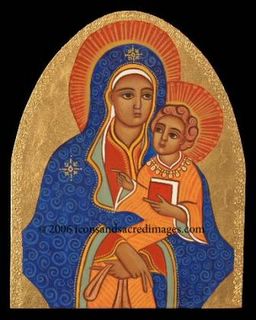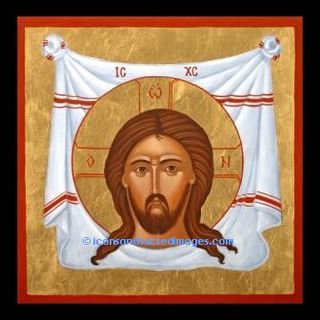Iconography and the Oriental Churches
Icons are a sacramental witness in color and shape of God's presence in His Church and the Gospel. What the Scriptures are in words, the Icons are in colors: a revelation of the Incarnation. God has come to dwell among us in a person whom we could see, touch and hear. When the Lord comes again, we shall then see face to face. Until then, we see by the light of faith.
A Treatise on the Veneration of the Holy Icons, written in Arabic circa 830 by the Bishop of Harran, Theodore Abu Qurrah, translated with notes by Dr. Sidney Griffith, CUA.
St. Paul writes that Christ is the icon of the invisible God. (Col 1.15)
Likewise, saints are spiritual icons of the indwelling Lord of Glory. So icons of Christ and the saints, viewed from the perspective of Heaven’s Glory, are called Windows into Heaven. They lift our heart & mind into the Heavenly Kingdom, they lift up our spiritual journey into Christ and His Mysteries.
On the RESOURCES page in left toolbar click on "Iconography."
NB.
The above linked seminary page provides a theological note regarding the catholicity of Orthodox soteriology and liturgical theology; it is not a page on liturgics.
- The "Icon of the Face Not Made by Human Hands" was given by the Lord to Abgar, King of Edessa. According to Eusebius and other sources King Abgar corresponded with the Lord, inviting Him to live in Edessa. Although the Lord declined, he sent a towel impressed with His likeness, the original "Made-Without-Hands Icon" (Mandylion). Later St. Thaddeus of the Seventy or another apostle is said to have brought the Gospel in full to Abgar's kingdom.
The Divine Liturgy of St. James of Jerusalem
with its many anaphoras born of the Near East,
visibly embodies the spirituality and sacramental mission of the Holy Icons.
with its many anaphoras born of the Near East,
visibly embodies the spirituality and sacramental mission of the Holy Icons.
- In the lyrical beauty of our liturgy we learn that “beauty will save the world,” because here, in faith and hope, we have indeed encountered the Lord of Heaven and earth and all that is visible and invisible -- we can see, and truly live, by the light of Christ.
And the Word became flesh
and dwelt among us,
and we have seen His glory,
glory as of the only-begotten from the Father,
full of grace and truth.
(Jn 1.14)
and dwelt among us,
and we have seen His glory,
glory as of the only-begotten from the Father,
full of grace and truth.
(Jn 1.14)
St. Ephrem the Syrian
and
Iconography in the Church
and
Iconography in the Church
Hugoye Syriac Studies
FURTHER STUDIES:
- N.B.
- read and see more photos of Mor Sabor Mor Aphroth Church at SOR.CUA
Please take care on these pages, and the websites linked here,
to distinguish the subject of sacred art from longstanding debates over socio-ethnic demographics and/or regarding ecclesiastical histories.
Akaparambu Mor Sabor Mor Aphroth Church:
examples of Syrian Orthodox wall murals in Kerala:
In these photos we see wall murals painted in an iconographic style.
It is important to note that these are not icons, but rather sacred art painted in an iconographic style.
Moreover, the paintings are done in a style originating not in India but elsewhere in the Middle East -- but then influenced by artistic traditions and customs local to India.

That these images were present does not mean that they were fully assimilated by the local churches, nor even that the images were widespread.
The images do indicate a specific aspect of the local church's receptivity to the larger Oriental Orthodox patrimony, wherein iconographic images, as well as actual icons, belong to the liturgical life of all the Oriental Orthodox Churches --
Another example of sacred art at Ankamaly Church
And from our own iconography ministries
at St. Ephrem Mission of Olympia
See "mission 3" and "N.B." of
The iconic spirituality is typified by the Oriental patrimony's longstanding veneration of the Holy Napkin (The Mandylion, also called “the Face Not Made by Human Hands”).
This hagiographic embrace is a typos of the Holy Icons per se.
That the icon is of Edessene origins “doubles the inheritance” belonging to the faithful of the Oriental Churches.
Certainly all eucharistic liturgy is iconographic,
yet the Syriac liturgy offers us a perspective
both powerful and persuasive --
directly and most eloquently -- through its beauty.
The rite is an extraordinarily lyrical love-song,
indeed a Song of Songs of the Church's Orthodox liturgies.
We encounter that lyricism as a theological font for revealing to us our salvation in Christ: the divinizing Mysteries of the Malankara Syriac Qurbana.



<< Home